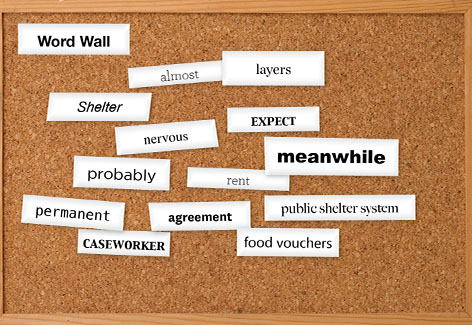What?
When?
During and after reading
Why?
Word walls support a language-rich learning environment. They foster word-consciousness and provide access to essential vocabulary, concepts and skills. Word walls reinforce sight-word acquisition with younger readers and build content literacy across grades and disciplines. Word walls help students see relationships between words and ideas.
How?
Organize your word wall vocabulary based on learning objectives and on the relationships among the words. For example, group words that begin with the letter “B,” words that are relevant to women’s suffrage or words that are synonyms for tolerance.
Word walls should reflect the character and culture of the classroom. Use index cards, sentence strips or construction paper on a wall, window or door. Lettering should be large, neat and visible from every seat in the classroom. Students can also contribute to the word wall; enlist students with artistic or spatial skills.
Before adding a word to the word wall, confirm that students understand its meaning within the context of the text. You can do this in any of the following ways:
- Ask students to use context clues, affixes, roots, word relationships or reference materials.
- Provide definitions for words that cannot be determined from context prior to reading.
- Explain unknown concrete and abstract words when encountered in the text. Reinforce abstract words after reading as students may take more time to understand them.
Reinforce new vocabulary by using flash cards, organizers and iterative activities that explore shades of meaning and morphology. Continued practice will enhance students' abilities to acquire and use a range of Tier Two and Tier Three words.
Adapt and expand your word wall so that students can reference it throughout the year. Alternately, rotate word walls with each new lesson or unit. Applications, such as Worldle, WordItOut and WordSift can help create digital word walls. Bright colors and pictures engage students and illustrate a wall’s overall theme.
English language learners
Word walls are a dedicated space English language learners can reference for learning support. To better support English language learners, modify your word wall to include words in students’ native languages, use pictures to represent words, or create personal word walls for students. Use personal word walls in other Word Work strategies such as concept sorts. Consider having two word walls for English language learners: one for Tier One and Tier Two words and another reserved for content-specific Tier Three words.
Connection to anti-bias education
Your word wall tells students which vocabulary you consider worth learning. Including vocabulary related to diversity makes your classroom a safe place for students to talk about personal or controversial topics. Making words accessible allows all students to engage in dialogue using the new vocabulary.
Sample Word Wall
- Choose your vocabulary words.
- Decide how to arrange your words (e.g., by first letter, number of syllables, ending sound, spelling rule, definition, part of speech, topic of study).
- Determine a classroom location for the display.
- Have students explain the words as you (or they) physically add them to the word wall.
- Ask students to point out which words deviate from typical spelling patterns.
- Practice the words by reading them aloud.
- Locate the words in the central text.
- Define the word as a group, using context clues from the central text.
- Chant each word while students write the word and its meaning in their personal word wall.
- Encourage students to retrieve words from the word wall during writing and discussion activities.
Sample Word Walls
The purpose of the personal word wall is to provide students with multiple exposures to new words. Students can exclude vocabulary words they have already mastered or include words from the text that are not part of the classroom word wall.

